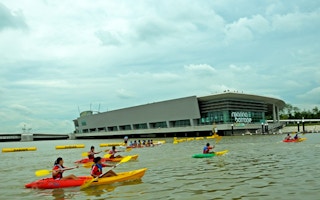Singapore’s Ministry of the Environment and Water Resources has launched a new book that tells the story of how the city-state tackled its environmental problems even as it rapidly developed over the past few decades.
The book, titled “Forging a Greener Tomorrow: Singapore’s environmental journey from slum to eco-city” commemorates the Ministry’s 40th anniversary this year.
Written by The Straits Times correspondent and Eco-Business founder Jessica Cheam, the 206-page tome describes Singapore’s transformation from a bustling, but polluted port with slum-like conditions into a high-tech modern city that is globally recognized for being clean and green.
It charts the Ministry’s 40-year journey so far in greening the city-state, an exercise that began when in 1972 when its first minister Lim Kim San emphasised the need for Singapore to differentiate itself from other Asian cities in its environment.
“The deterioration of the environment will bring in its wake innumerable health problems which will in turn stifle our development. Singapore cannot afford the mistakes of these large cities,” he said then.
The Ministry’s 3P Network acting director Melvin Koh said in a statement that the book showcases the “tireless efforts of many people over the past 40 years in the area of environment management, and how going forward, a close partnership with the community is necessary”.
The 3P Network is a government project that promotes cooperation amongst people, public agencies and private groups to improve Singapore’s environment.
MEWR will distribute the book to libraries and schools throughout Singapore, and add a down-loadable PDF version to its website after the launch.
The Singapore River, which was known in the early days as the reeking, trash-strewn transfer hub for the Republic’s shipping trade, features prominently in the book. The government started a drastic clean-up of the river in the 1980s as part its long-term plan to become water self-sufficient.
Water security has been a national concern since Singapore’s 1959 independence from the British and the subsequent political separation from Malaysia in 1965. At the time of separation, Singapore’s 1.9 million people depended almost entirely on fresh water imported from neighbouring Malaysia under two bilateral agreements. The first agreement expired last year and the second expires in 2061.
Lee Kuan Yew, Singapore’s first prime minister set the stage for the current water security plan in 1977 when he asked Lee Ek Tieng, who at the time was chairman of the national water agency PUB, “Suppose we could capture every drop of rain in Singapore, could we become self-sufficient?”
Since then, Singapore has developed a national water strategy that calls for the capture of all fresh water run-off from the island, extensive wastewater recycling, desalination and water efficiency programmes for the public and industries.
The book also delves into the government’s work to achieve PM Lee’s vision of a clean and green city through decades of sustained efforts to improve infrastructure and housing, plant trees and run public campaigns on cleanliness and conservation.
Ken Hickson, chief executive of Singapore-based sustainability consultancy Sustain Ability Showcase Asia (SASA) noted that the publication was more than merely a commemorative chronicle.
“The book doesn’t just dwell on the past. Through policies, people and places, Jessica (Ms Cheam) weaves a convincing tale of past successes in overcoming formidable challenges and shows where sensible and far-sighted planning has re-designed and re-made Singapore into an environmentally-sustainable urban role model,” he told Eco-Business.
He added that the government will have to keep applying the lessons it has learnt so that it can cope with new and recurring environmental challenges.
Co-founder of Singapore’s grassroots Green Drinks network Olivia Choong told Eco-Business that the government has done well promoting environmental awareness with the public and businesses through grants, information resources and green spaces. She noted she would like to see more initiatives in areas such as energy efficiency and recycling.
“And there needs to be a way to engage citizens to co-create public spaces to encourage a sense of ownership of our country and a tighter community bond,” she further noted.
The book is one way for Singapore‘s environment ministry to reach out.
“We hope the book will allow readers, especially our youths, to better appreciate and take ownership of our environment,” said MEWR’s Mr Koh.
Mr Hickson of SASA noted that efforts such these are paying off, and that the youth in particular show increasing environmental awareness and a desire to help. He added that Singapore needed to find more opportunities for environmental action involving government, private sector, NGOs, community groups and the media.
“Singapore has made a good start but there needs to be more people power - people involved and promoting environmentally friendly actions,” he said.










